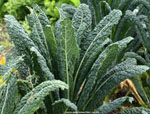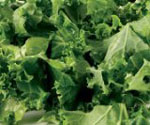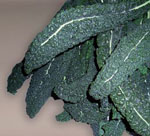Green leafy vegetables return in the fall for our eating pleasure. After a summer of eggplant, summer squash and tomatoes, it’s a pleasure to have something green and leafy in my diet. And for me, one of my favorites is Kale.
Most greens bolt in the heat of summer, so they are a welcome addition to our fall diets. Kale also grows well into winter so its one of the few green vegetables that are available when the weather is cold. Kale sweetens up after being exposed to a frost and actually freezes quite well. It has been used in many culinary cultures from the Irish Colcannan to the Portuguese Caldo Verde.
Kale is a member of the cabbage family and as such is a powerhouse of nutrients. Its high in beta carotene, Vitamin C and calcium. It also contains sulforaphae, which is anti-cancer properties. Kale is also very high in Vitamin K, and should not be eaten while on blood thinners such as heparin or coumadin. It’s also contains about 36 calories per cup, and has 5 grams of fiber. Kale is high in omega-3 (100 calories of kale provides 25-35% of the National Academy of Science’s recommendation for ALA (alpha-linolenic acid), which is the most basic omega-3 fatty acid. Kale also contains a measurable amount of oxalates, which can be a problem for people with kidney or gallbladder problems.
Kale is a food that should be bought from your local farmer or in organic form since it is one of the 12 foods in which pesticide residue has been found most frequently.
If you are lucky enough to have year round farmers markets, you might see the following types of Kale
Regardless of the variety, Kale will keep for 3-5 days in your refrigerator, unwashed in a plastic bag. To prep kale, fill a large bowl (or salad spinner) with water and 1 to 2 TBS lemon juice or apple cider vinegar and let soak for 5-10 minutes. Rinse and then dry kale throughly (this is where a salad spinner helps). Separate leaves and stalks. Some recipes will use the stalks, all recipes will use the leaves.
If the kale you purchase is young and tender, it can be used in a salad like most other leafy green vegetables, you can also slice more mature kale thinly for your salad. Otherwise it should be cooked. Kale can be steamed, sautéed, used in stews and soups and baked for yummy kale chips.
Recipes for Kale
- Baked Kale is a healthy snack. One of my favorite ways to prepare them is with vinegar and salt
- Colcannon is a traditional Irish dish made with Kale (or cabbage) , onions and cream
- A traditional use of kale in Portugal is Caldo Verde
- Potato, Kale and Sausage Soup
- Sweet and Savory Kale Side Dish
- Kale Salad



